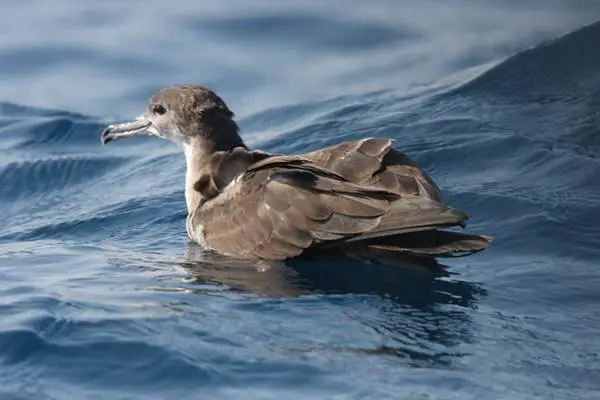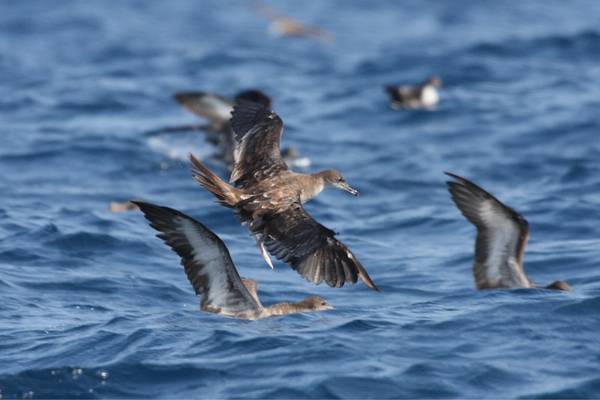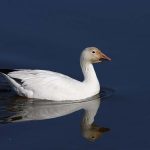Common Name: Wedge-tailed Shearwater
Scientific Name: Ardenna pacifica| Size | Diet | Range in Hawaii | Status in Hawaii |
|---|---|---|---|
| 16 in. - 18 in. | squid and small fish | All Islands | Least Concern |
The Wedge-tailed Shearwater, also known as the ‘ua’u kani, is a seabird species found in the U.S. state of Hawaii with an estimated population of around 30,000 individuals. They are a medium-sized shearwater and is known for its distinctive tail shape, which gives it its common name.
Wedge-tailed Shearwater

APPEARANCE
The Wedge-tailed shearwater measures about 40-45 cm (16-18 inches) in length, with a wingspan of about 96 cm (38 inches). This bird has a distinctive, wedge-shaped tail, which gives it its common name.
In terms of coloration, the Wedge-tailed Shearwater has a dark brown upper body, with white underparts. The head is white with a dark line running through the eye. The wings are dark brown with white tips. The feet and legs are pinkish-white. Juvenile birds are similar in appearance to adults but have a darker brown coloration, and can be identified by their dark bill.
DIET
The Wedge-tailed Shearwater feeds mainly on squid and small fish. These birds spend most of their time out at sea, flying long distances to find food. They are known to take a variety of prey including fish such as herring, sardines, mackerel and anchovies, as well as squid and crustaceans.
Wedge-tailed Shearwater are also known to take smaller amounts of jellyfish, plankton, and other marine invertebrates. They have been observed hunting alone, in pairs or in flocks, and have been known to follow ships in search of food.
Wedge-tailed Shearwater forage by diving from the surface of the water, and can stay underwater for several minutes at a time. Their diet changes throughout the breeding season, with a higher proportion of squid and fish during the breeding season.
BEHAVIOR
Wedge-tailed Shearwater are known to be highly pelagic, spending most of their time at sea, only coming to land to breed. During the breeding season, which typically runs from April to September, Wedge-tailed Shearwaters return to their colonies to breed.
They breed in colonies, often with other seabird species, and typically nest in burrows or on cliffs. They are monogamous and pairs often return to the same burrow or site year after year. The male and female share in the incubation of the eggs, and both parents take turns caring for the chicks.
NESTING
The Wedge-tailed Shearwater are known to nest in crevices, rock ledges, or abandoned burrows of other seabirds. The female lays a single egg, and both parents take turns incubating the egg, which takes about 56 days to hatch.
The chicks are fed by both parents and fledge at around 70 to 80 days after hatching. Wedge-tailed Shearwater chicks are precocial, meaning they are able to move around and feed on their own soon after hatching.
HABITAT

Wedge-tailed Shearwaters are typically found on coastal cliffs, rocky shores and sandy beaches, and they prefer to breed on remote, undisturbed islands with adequate protection against predators. The burrows or nests are usually dug into soil or sand, and can be located on the coast, cliffs or in the vegetation. They also use crevices, rock ledges, or abandoned burrows of other seabirds as nesting sites.
RANGE
The species is widely distributed throughout the islands including Kauai, Oahu, Molokai, Maui, and Big Island.
CONSERVATION STATUS
The Wedge-tailed Shearwater is considered to be a species of Least Concern by the International Union for Conservation of Nature (IUCN).
INTERESTING FACTS
1. A long-lived species
The Wedge-tailed Shearwater is a long-lived species, with some individuals known to live for more than 30 years.
2. A nocturnal breeder
The Wedge-tailed Shearwater is a nocturnal breeder, returning to its breeding colony at night to mate and care for its young.
3. A colonial nester
The Wedge-tailed Shearwater is a colonial nester, with some colonies containing tens of thousands of breeding pairs.
4. They has a complex and synchronized breeding system
The Wedge-tailed Shearwater has a complex and synchronized breeding system, with all individuals in a colony breeding at the same time.
5. Known to their distinct call
The wedge-tailed shearwaters are known for their distinctive calls, which include a variety of wails and moans. These calls are a key feature of the species and likely contributed to the bird’s Hawaiian name, ‘ua’u kani, which means “calling or moaning petrel.” The calls are particularly loud and persistent at their breeding colonies, and are used to communicate with other members of the colony and to defend their territories.
FREQUENTLY ASKED QUESTIONS:
Where do wedge-tailed shearwaters live?
They typically live in the Hawaiian islands, but they typically breed on the uninhabited islands and atolls in the northwestern Hawaiian Islands such as French Frigate Shoals, Laysan Island, and Midway Atoll. They are seabirds that spend most of their lives at sea, coming to land only to breed and raise their young.
What are some of the diseases that can affect their population?
Wedge-tailed shearwaters are susceptible to a number of diseases, some of which can have a significant impact on their populations. Some of the diseases that have been reported in this species include avian influenza, avian cholera, and avian paramyxovirus.
They can also be affected by avian pox, a viral infection that causes skin tumors, and avian botulism, a bacterial infection that can cause paralysis and death. In addition, some wedge-tailed shearwaters may also be affected by pollution, oil spills, and human activities such as habitat destruction.
What are the predators of Wedge-tailed shearwater?
At sea, adult shearwaters are preyed upon by large predatory fish such as tuna and sharks, as well as by larger seabirds such as the great frigatebird and the short-tailed albatross.




